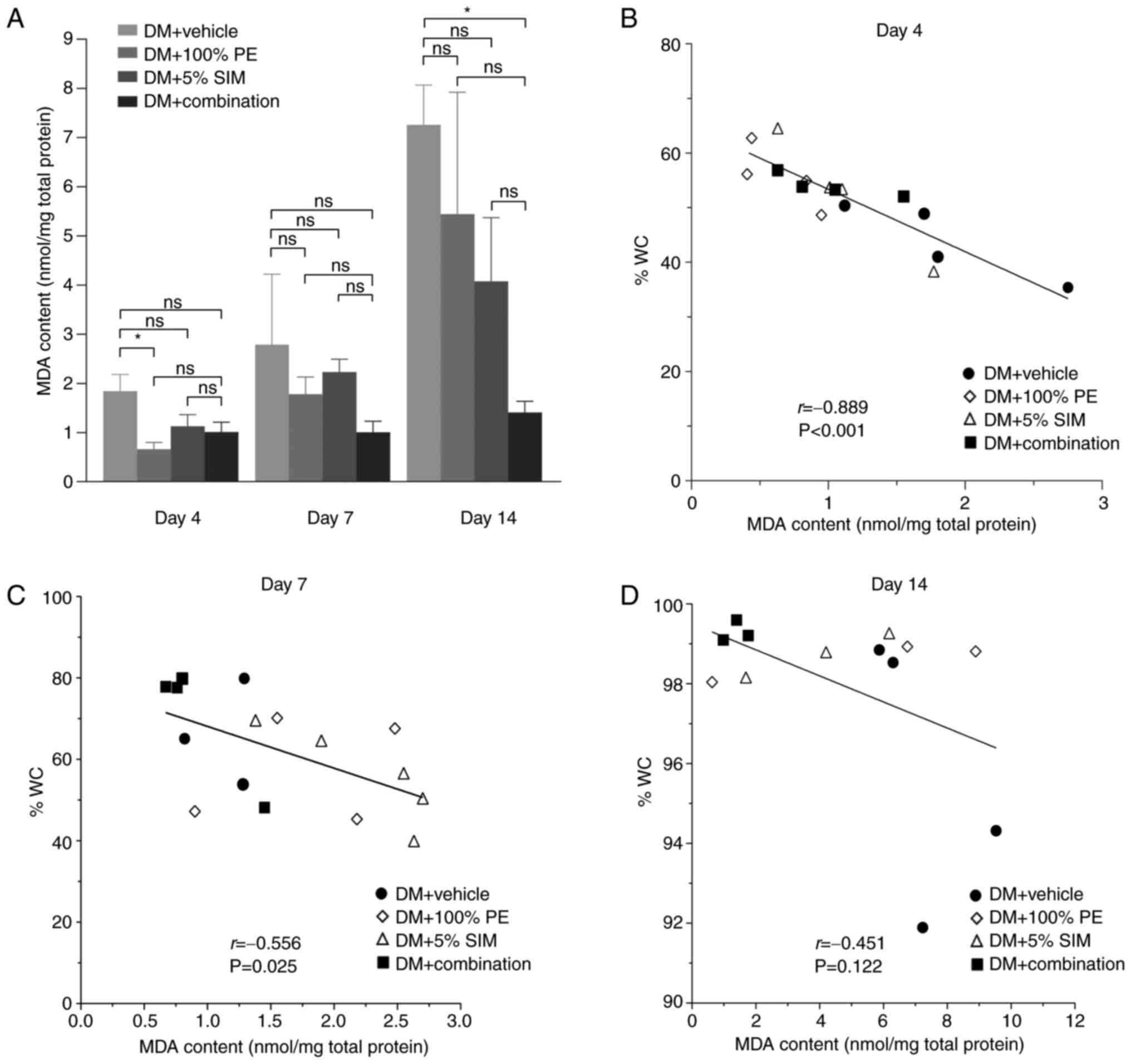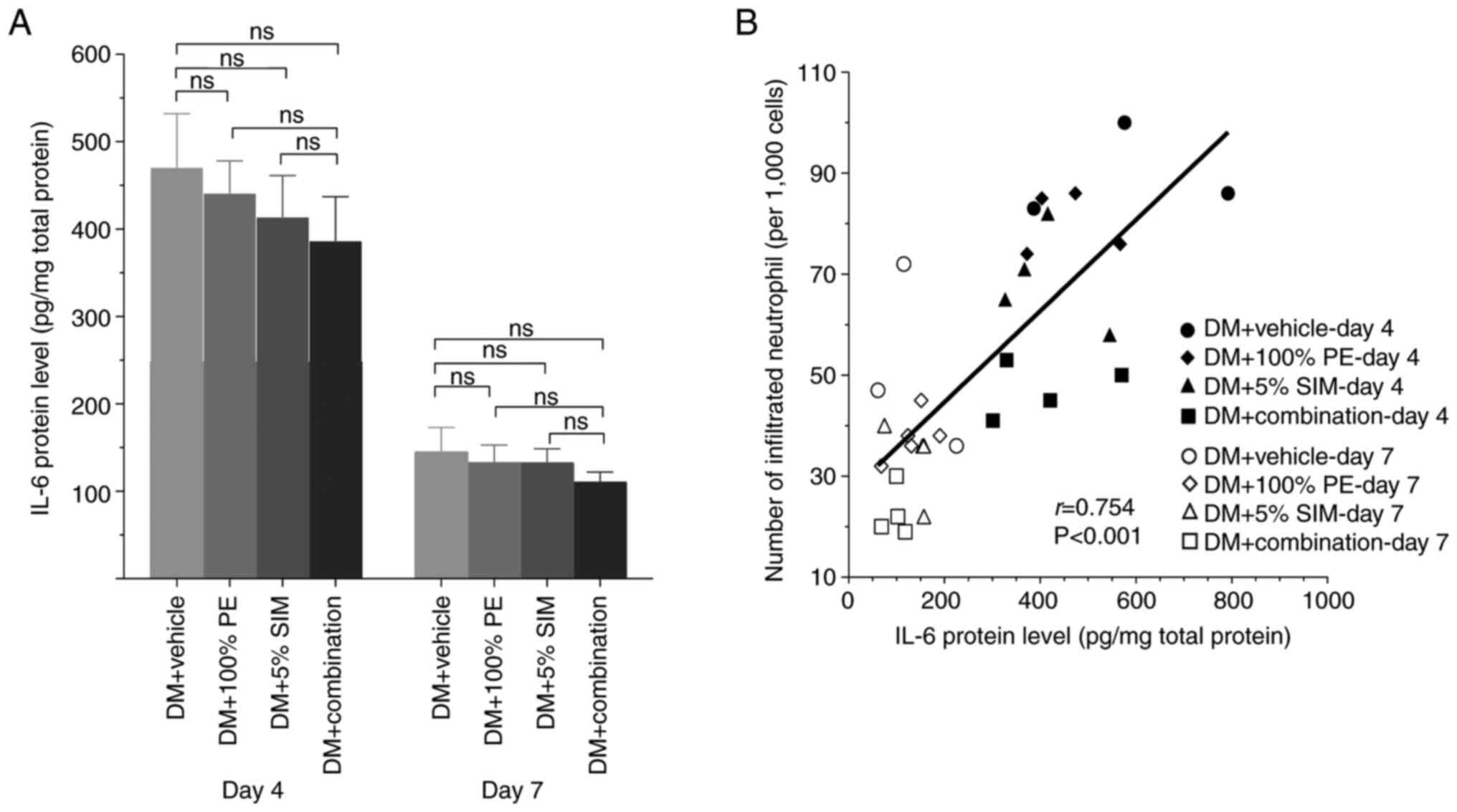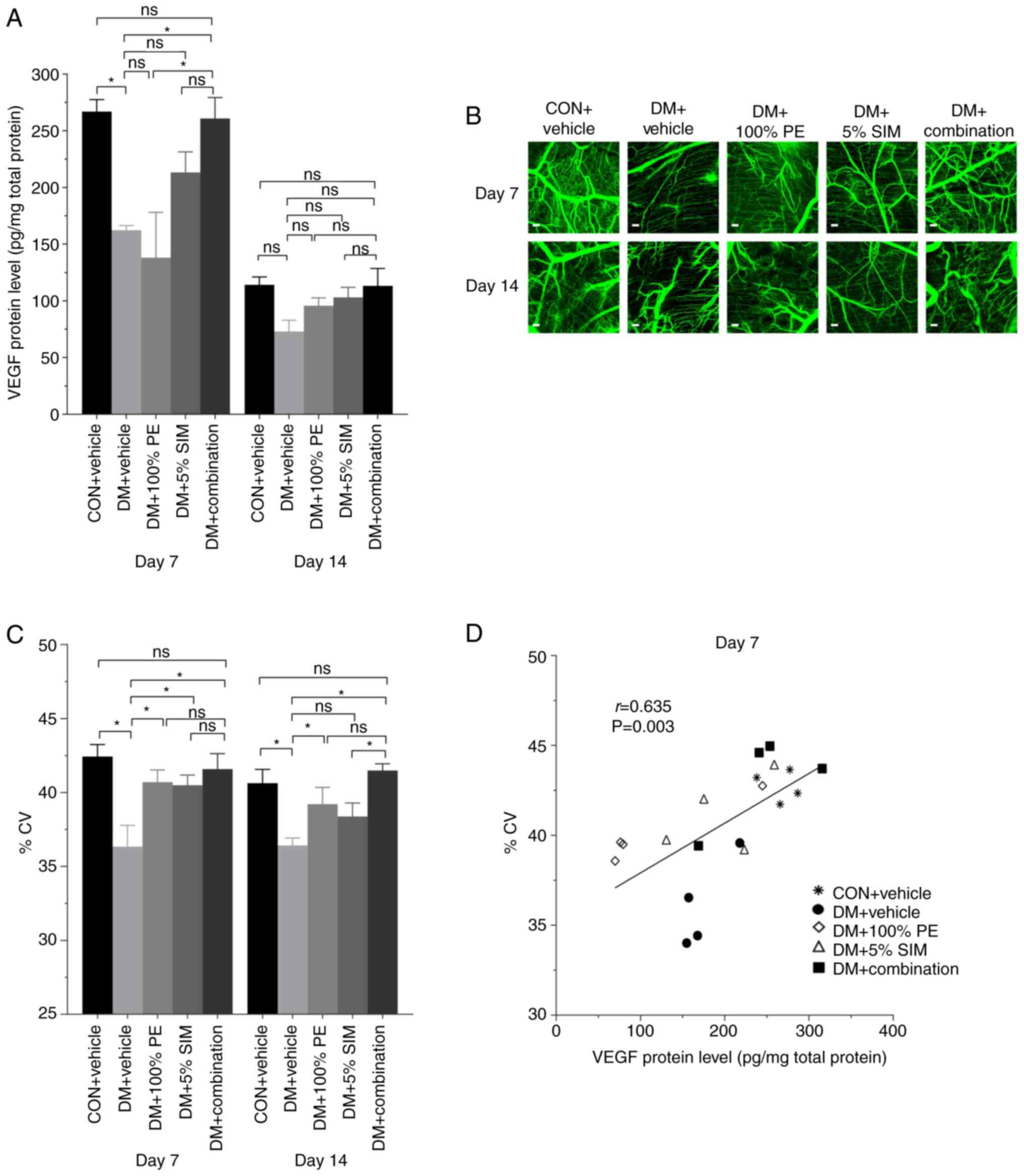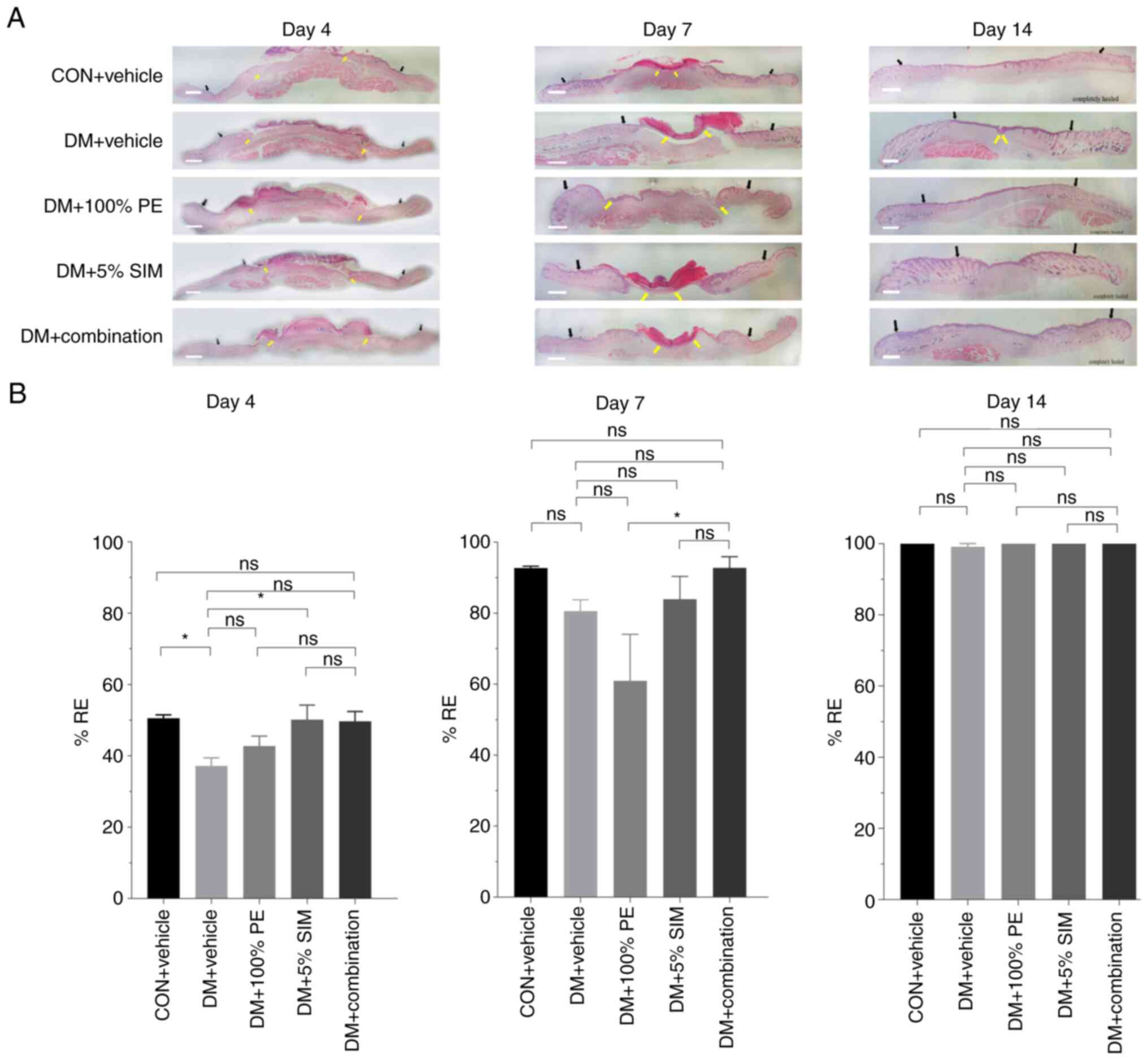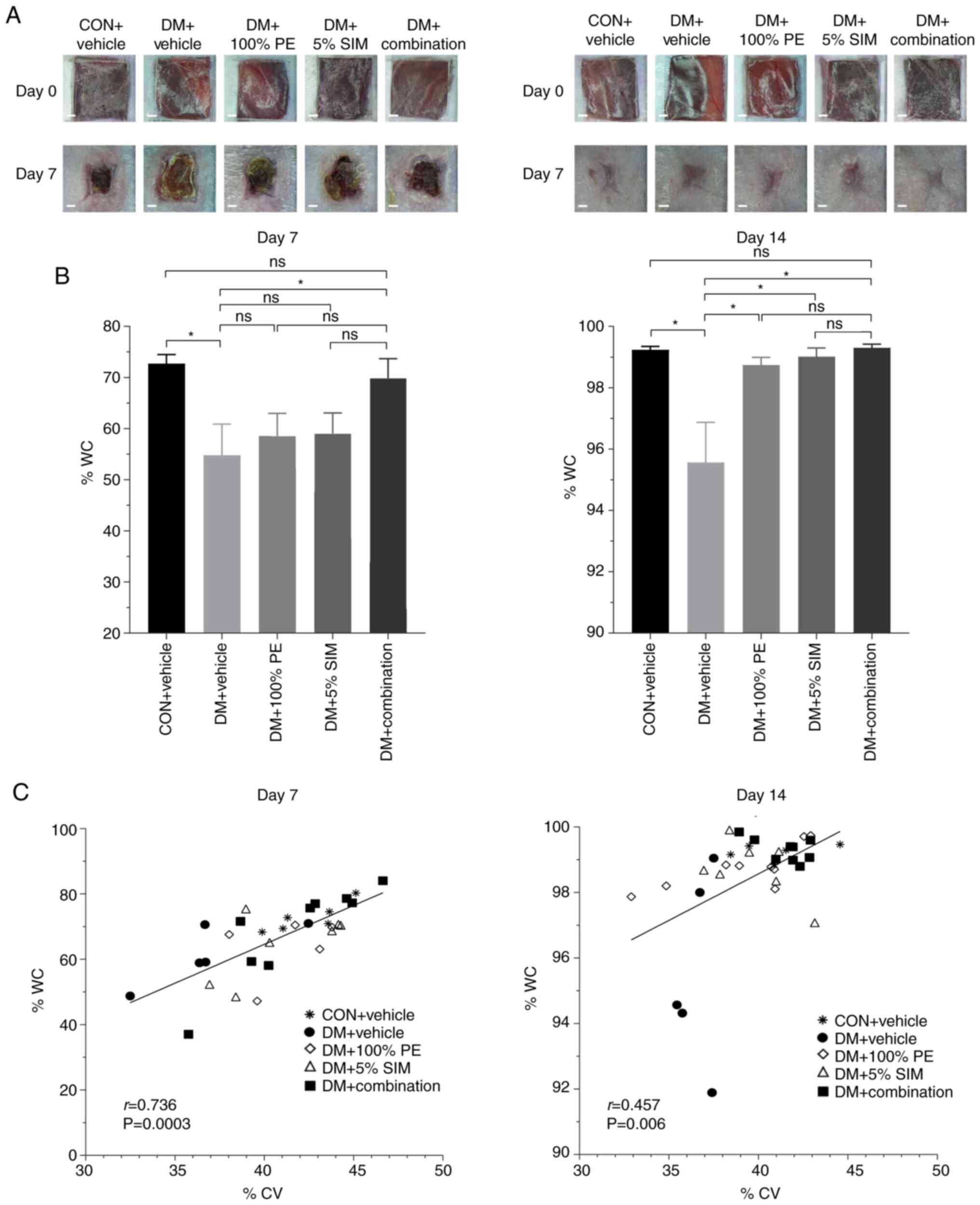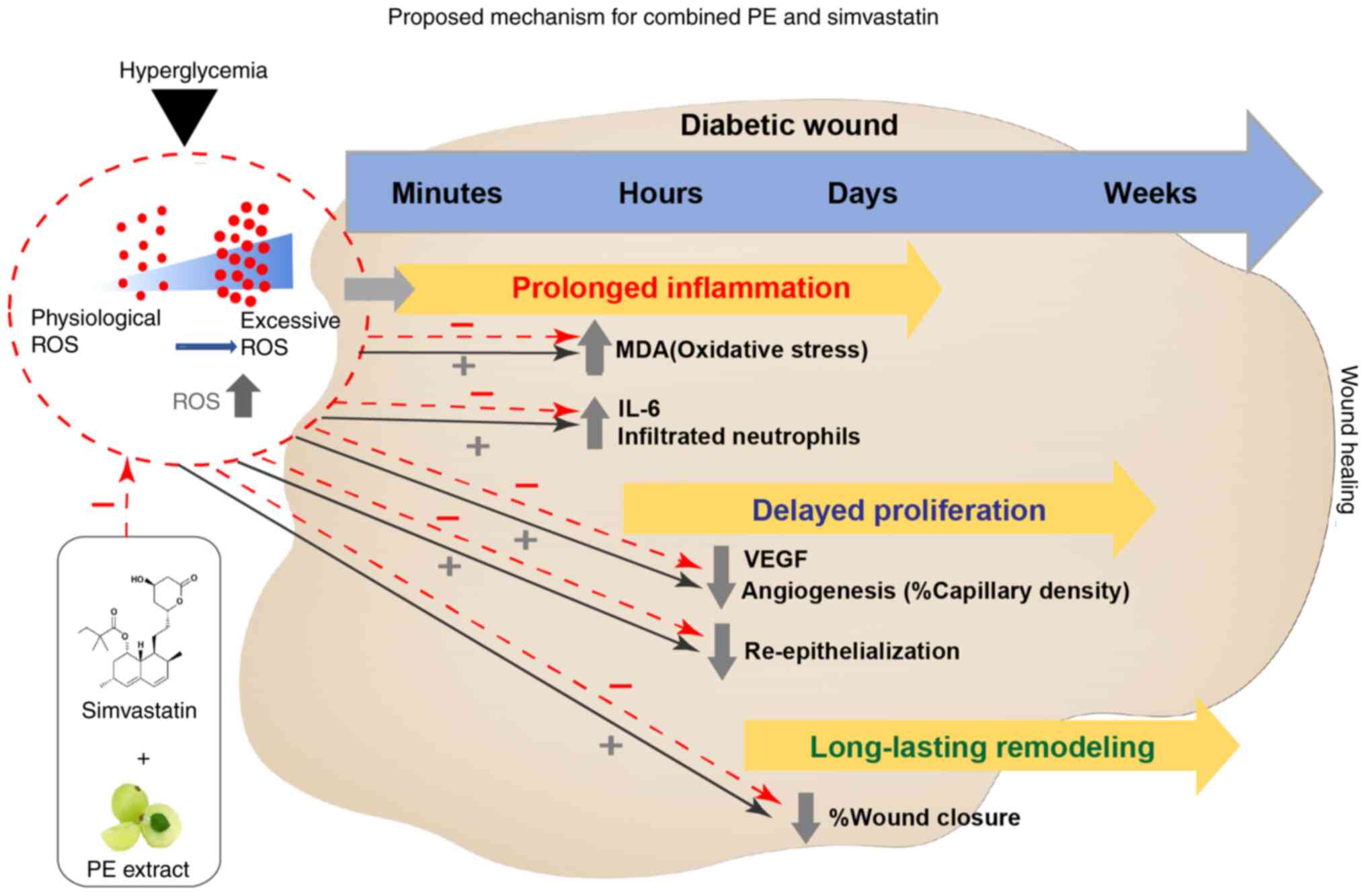|
1
|
Alexiadou K and Doupis J: Management of
diabetic foot ulcers. Diabetes Ther. 3(4)2012.PubMed/NCBI View Article : Google Scholar
|
|
2
|
Johnson JB, Broszczak DA, Mani JS, Anesi J
and Naiker M: A cut above the rest: Oxidative stress in chronic
wounds and the potential role of polyphenols as therapeutics. J
Pharm Pharmacol. 74:485–502. 2022.PubMed/NCBI View Article : Google Scholar
|
|
3
|
González AC, Costa TF, Andrade ZA and
Medrado AR: Wound healing-A literature review. An Bras Dermatol.
91:614–620. 2016.PubMed/NCBI View Article : Google Scholar
|
|
4
|
Bitto A, Minutoli D, Altavilla D, Polito
F, Fiumara T, Marini H, Galeano M, Calò M, Cascio PL, Bonaiuto M,
et al: Simvastatin enhances VEGF production and ameliorates
impaired wound healing in experimental diabetes. Pharmacol Res.
57:159–169. 2008.PubMed/NCBI View Article : Google Scholar
|
|
5
|
Sukpat S, Israsena N and Patumraj S:
Pleiotropic effects of simvastatin on wound healing in diabetic
mice. J Med Assoc Thai. 99:213–219. 2016.PubMed/NCBI
|
|
6
|
Rego AC, Araújo Filho IA, Damasceno BP,
Egito ES, Silveira IA, Brandão-Neto J and Medeiros AC: Simvastatin
improves the healing of infected skin wounds of rats. Acta Cir
Bras. 22 (Suppl 1):S57–S63. 2007.PubMed/NCBI View Article : Google Scholar
|
|
7
|
Asai J, Takenaka H, Hirakawa S, Sakabe J,
Hagura A, Kishimoto S, Maruyama K, Kajiya K, Kinoshita S, Tokura Y
and Katoh N: Topical simvastatin accelerates wound healing in
diabetes by enhancing angiogenesis and lymphangiogenesis. Am J
Pathol. 181:2217–2224. 2012.PubMed/NCBI View Article : Google Scholar
|
|
8
|
Wang CC, Yang PW, Yang SF, Hsieh KP, Tseng
SP and Lin YC: Topical simvastatin promotes healing of
Staphylococcus aureus-contaminated cutaneous wounds. Int Wound J.
13:1150–1157. 2016.PubMed/NCBI View Article : Google Scholar
|
|
9
|
Yadav SS, Singh MK, Singh PK and Kumar V:
Traditional knowledge to clinical trials: A review on therapeutic
actions of emblica officinalis. Biomed Pharmacother. 93:1292–1302.
2017.PubMed/NCBI View Article : Google Scholar
|
|
10
|
Chansriniyom C, Bunwatcharaphansakun P,
Eaknai W, Nalinratana N, Ratanawong A, Khongkow M and
Luechapudiporn R: A synergistic combination of Phyllanthus emblica
and Alpinia galanga against H2O2-induced
oxidative stress and lipid peroxidation in human ECV304 cells. J
Funct Foods. 43:44–54. 2018.
|
|
11
|
Ansari A, Shahriar MS, Hassan MM, Das SR,
Rokeya B, Haque MA, Haque ME, Biswas N and Sarkar T: Emblica
officinalis improves glycemic status and oxidative stress in STZ
induced type 2 diabetic model rats. Asian Pac J Trop Med. 7:21–25.
2014.PubMed/NCBI View Article : Google Scholar
|
|
12
|
Usharani P, Fatima N and Muralidhar N:
Effects of Phyllanthus emblica extract on endothelial dysfunction
and biomarkers of oxidative stress in patients with type 2 diabetes
mellitus: A randomized, double-blind, controlled study. Diabetes
Metab Syndr Obes. 6:275–284. 2013.PubMed/NCBI View Article : Google Scholar
|
|
13
|
Muthuraman A, Sood S and Singla SK: The
antiinflammatory potential of phenolic compounds from Emblica
officinalis L. in rat. Inflammopharmacology. 19:327–334.
2011.PubMed/NCBI View Article : Google Scholar
|
|
14
|
Golechha M, Sarangal V, Ojha S, Bhatia J
and Arya DS: Anti-inflammatory effect of Emblica officinalis in
rodent models of acute and chronic inflammation: Involvement of
possible mechanisms. Int J Inflam. 2014(178408)2014.PubMed/NCBI View Article : Google Scholar
|
|
15
|
National Research Council of Thailand
(NRCT), The Ethical Principles for the Use of Animal for Scientific
Purposes (2015).
|
|
16
|
Sukpat S, Isarasena N, Wongphoom J and
Patumraj S: Vasculoprotective effects of combined endothelial
progenitor cells and mesenchymal stem cells in diabetic wound care:
Their potential role in decreasing wound-oxidative stress. BioMed
Res Int Jan. 2013(459196)2013.PubMed/NCBI View Article : Google Scholar
|
|
17
|
Liao TT, Sukpat S, Chansriniyom C and
Patumraj S: Dose-dependent effect of local treatment of
Phyllanthus emblica L. cream on diabetic wound. Chula Med J.
66:129–136. 2022.
|
|
18
|
Cano Sanchez M, Lancel S, Boulanger E and
Neviere R: Targeting oxidative stress and mitochondrial dysfunction
in the treatment of impaired wound healing: A systematic review.
Antioxidants (Basel). 7(98)2018.PubMed/NCBI View Article : Google Scholar
|
|
19
|
Fakhruddin S, Alanazi W and Jackson KE:
Diabetes-induced reactive oxygen species: Mechanism of their
generation and role in renal injury. J Diabetes Res.
2017(8379327)2017.PubMed/NCBI View Article : Google Scholar
|
|
20
|
El-Benna J, Hurtado-Nedelec M, Marzaioli
V, Marie JC, Gougerot-Pocidalo MA and Dang PM: Priming of the
neutrophil respiratory burst: Role in host defense and
inflammation. Immunol Rev. 273:180–193. 2016.PubMed/NCBI View Article : Google Scholar
|
|
21
|
Zinellu A, Paliogiannis P, Usai MF, Carru
C and Mangoni AA: Effect of statin treatment on circulating
malondialdehyde concentrations: A systematic review and
meta-analysis. Ther Adv Chronic Dis.
10(2040622319862714)2019.PubMed/NCBI View Article : Google Scholar
|
|
22
|
Cowled PA, Khanna A, Laws PE, Field JB,
Varelias A and Fitridge RA: Statins inhibit neutrophil infiltration
in skeletal muscle reperfusion injury. J Surg Res. 141:267–276.
2007.PubMed/NCBI View Article : Google Scholar
|
|
23
|
Zhang Y, Rong S, Feng Y, Zhao L, Hong J,
Wang R and Yuan W: Simvastatin attenuates renal
ischemia/reperfusion injury from oxidative stress via targeting
Nrf2/HO-1 pathway. Exp Ther Med. 14:4460–4466. 2017.PubMed/NCBI View Article : Google Scholar
|
|
24
|
Wang F and Wang H: Phyllanthus emblica L.
extract activates Nrf2 signalling pathway in HepG2 cells. Biomed
Res. 28:3383–3386. 2017.
|
|
25
|
Nain P, Saini V, Sharma S and Nain J:
Antidiabetic and antioxidant potential of Emblica officinalis
Gaertn. leaves extract in streptozotocin-induced type-2 diabetes
mellitus (T2DM) rats. J Ethnopharmacol. 142:65–71. 2012.PubMed/NCBI View Article : Google Scholar
|
|
26
|
Rezaie-Majd A, Maca T, Bucek RA, Valent P,
Müller MR, Husslein P, Kashanipour A, Minar E and Baghestanian M:
Simvastatin reduces expression of cytokines interleukin-6,
interleukin-8, and monocyte chemoattractant protein-1 in
circulating monocytes from hypercholesterolemic patients.
Arterioscler Thromb Vasc Biol. 22:1194–1199. 2002.PubMed/NCBI View Article : Google Scholar
|
|
27
|
Paumelle R, Blanquart C, Briand O, Barbier
O, Duhem C, Woerly G, Percevault F, Fruchart JC, Dombrowicz D,
Glineur C and Staels B: Acute anti-inflammatory properties of
statins involve peroxisome proliferator–activated receptor-α via
inhibition of the protein kinase C signaling pathway. Circ Res.
98:361–369. 2006.PubMed/NCBI View Article : Google Scholar
|
|
28
|
Chatterjee A, Chatterjee S, Biswas A,
Bhattacharya S, Chattopadhyay S and Bandyopadhyay SK: Gallic acid
enriched fraction of Phyllanthus emblica potentiates
indomethacin-induced gastric ulcer healing via e-NOS-dependent
pathway. Evid Based Complement Alternat Med.
2012(487380)2012.PubMed/NCBI View Article : Google Scholar
|
|
29
|
Khoshneviszadeh M, Ashkani-Esfahani S,
Namazi MR, Noorafshan A, Geramizadeh B and Miri R: Topical
simvastatin enhances tissue regeneration in full-thickness skin
wounds in rat models. Iran J Pharm Sci. 13:263–269. 2014.PubMed/NCBI
|
|
30
|
Rossi J, Rouleau L, Tardif JC and Leask
RL: Effect of simvastatin on Kruppel-like factor2, endothelial
nitric oxide synthase and thrombomodulin expression in endothelial
cells under shear stress. Life Sci. 87:92–99. 2010.PubMed/NCBI View Article : Google Scholar
|
|
31
|
Braiman-Wiksman L, Solomonik I, Spira R
and Tennenbaum T: Novel insights into wound healing sequence of
events. Toxicol Pathol. 35:767–779. 2007.PubMed/NCBI View Article : Google Scholar
|
|
32
|
Poltanov EA, Shikov AN, Dorman HD,
Pozharitskaya ON, Makarov VG, Tikhonov VP and Hiltunen R: Chemical
and antioxidant evaluation of Indian gooseberry (Emblica
officinalis Gaertn., syn. Phyllanthus emblica L.) supplements.
Phytother Res. 23:1309–1315. 2009.PubMed/NCBI View
Article : Google Scholar
|
|
33
|
Pozharitskaya ON, Ivanova SA, Shikov AN
and Makarov VG: Separation and evaluation of free
radical-scavenging activity of phenol components of Emblica
officinalis extract by using an HPTLC–DPPH* method. J Sep Sci.
30:1250–1254. 2007.PubMed/NCBI View Article : Google Scholar
|
|
34
|
Scartezzini P, Antognoni F, Raggi MA, Poli
F and Sabbioni C: Vitamin C content and antioxidant activity of the
fruit and of the Ayurvedic preparation of Emblica officinalis
Gaertn. J Ethnopharmacol. 104:113–118. 2006.PubMed/NCBI View Article : Google Scholar
|
|
35
|
Fatima N, Pingali U and Muralidhar N:
Study of pharmacodynamic interaction of Phyllanthus emblica extract
with clopidogrel and ecosprin in patients with type II diabetes
mellitus. Phytomedicine. 21:579–585. 2014.PubMed/NCBI View Article : Google Scholar
|















